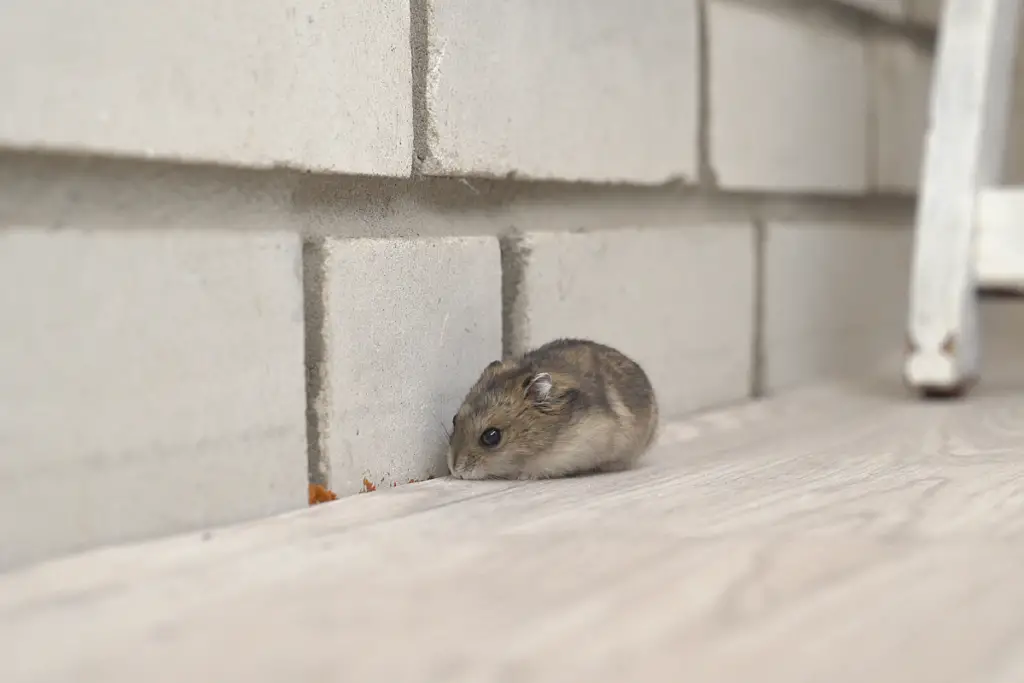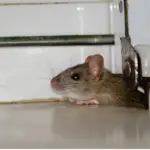Rats can be a major nuisance in homes, causing damage to property and spreading diseases. They can enter homes through small cracks and gaps, making it difficult to keep them out.
If you are dealing with a rat infestation, it’s important to take action quickly to prevent further damage and potential health risks.
There are several methods for getting rid of rats in houses fast. One approach is to seal any cracks and gaps in walls, floors, and foundations to prevent rats from entering the home.
Traps are also effective at catching rats, with snap traps being the least expensive option. Electronic traps that use electricity to kill rats are considered the most humane method.
Poison baits are another option, but they should be used with caution and kept away from children and pets.
Finally, professional exterminators can be hired to eliminate a rat infestation.

Table of Contents
Identifying the Problem
When it comes to dealing with a rat infestation, the first step is to identify the problem. This involves looking for common signs of a rat infestation and locating the source of the infestation.
Common signs of a rat infestation
There are several signs that can indicate the presence of rats in a house. These include:
- Droppings: Rat droppings are typically dark brown or black and tapered at the ends. They are usually found in areas where rats are active, such as along walls, in cabinets, and under sinks.
- Gnaw marks: Rats have strong teeth and will gnaw on almost anything, including wood, plastic, and electrical wires. Gnaw marks on walls, furniture, and other objects can indicate the presence of rats.
- Grease marks: Rats have oily fur that can leave greasy marks on surfaces they come into contact with. Look for greasy smudges along walls and baseboards.
- Scratching noises: Rats are most active at night and can be heard scratching and scurrying in walls, ceilings, and floors.
- Nesting materials: Rats will use a variety of materials to build their nests, including shredded paper, fabric, and insulation. Look for these materials in areas where rats are active.
Locating the source of the infestation
Once you have identified the signs of a rat infestation, the next step is to locate the source of the infestation.
This can be done by inspecting the house for entry points and areas where rats are active.
- Entry points: Rats can enter a house through small cracks and gaps in the walls, foundation, and roof. Inspect the house for these entry points and seal them with caulk, wire mesh, or other materials.
- Areas of activity: Rats prefer to stay close to their nests and will often establish their nests in hidden areas such as attics, basements, and crawl spaces. Look for signs of activity in these areas, such as droppings, gnaw marks, and nesting materials.
- Food sources: Rats are attracted to food and will often establish their nests near sources of food. Inspect the house for food sources such as garbage cans, pet food, and bird feeders. Keep these areas clean and secure to discourage rats from entering the house.
By identifying the signs of a rat infestation and locating the source of the infestation, homeowners can take the necessary steps to get rid of rats in their house quickly and effectively.
Preventative Measures
Preventing rats from entering a home is the best way to avoid an infestation. There are several measures that homeowners can take to prevent rats from entering their homes.
Sealing Entry Points
Rats can enter a home through small openings, so it is important to seal all entry points.
Homeowners should inspect their homes for any cracks or holes and seal them with caulk or steel wool.
They should also check for gaps in doors and windows and install weather stripping if necessary.
Removing Potential Food Sources
Rats are attracted to food sources, so homeowners should remove any potential food sources from their homes.
This includes storing food in sealed containers, cleaning up spills and crumbs immediately, and taking out the trash regularly.
Homeowners should also avoid leaving pet food out overnight.
Maintaining Cleanliness
Maintaining a clean home is essential to preventing a rat infestation. Homeowners should regularly clean their homes and remove clutter to eliminate potential hiding places for rats.
They should also clean up any standing water and fix any leaks to prevent rats from accessing water sources.
By taking these preventative measures, homeowners can significantly reduce the risk of a rat infestation in their homes.
Traps and Baits
When it comes to getting rid of rats, traps and baits are some of the most popular methods.
In this section, we will discuss the different types of traps and baits available, as well as proper placement techniques.
Types of Traps and Baits
There are several types of traps and baits available for rat control. Here are some of the most common:
- Snap Traps: These are the most traditional type of trap. They consist of a wooden or plastic base and a metal bar that snaps shut when the rat takes the bait.
- Glue Traps: These traps use a sticky adhesive to trap the rat. They are not recommended as they can cause the rat to suffer a slow and painful death.
- Electronic Traps: These traps use a high-voltage shock to kill the rat quickly and humanely.
- Poison Baits: These baits contain a toxic substance that kills the rat when ingested.
Proper Placement of Traps and Baits
Proper placement of traps and baits is essential for effective rat control. Here are some tips for proper placement:
- Place traps and baits in areas where rats are likely to travel, such as along walls and in corners.
- Use multiple traps and baits to increase your chances of success.
- Keep traps and baits out of reach of children and pets.
- Check traps and baits regularly and dispose of dead rats immediately.
- If using poison baits, be sure to follow the manufacturer’s instructions carefully.
In conclusion, traps and baits can be effective tools for getting rid of rats in your home.
However, it is important to use them properly and safely to avoid harm to yourself, your family, and your pets.
- Take Back Your Home from mice, rats, or other rodents with the powerfully effective tunnel rat traps by Kat Sense. Designed to be clean, reusable, and effective with a 99% trap rate!
- Don’t Want To Peel disease-prone rodents from your traps once they’re caught? Our touch-free tunnel rat trap design does the hard work for you. Never touch a filthy rat, mouse, or another rodent again with our super-clean touch-free pest disposal!
- Give Your Children and pets a rodent-free home with these tunnel traps designed to keep them secure. All trapping mechanisms are inside of the trap making this pest control device friendly for both pets and kids.
- Effective, Reusable, And Humane, but they won’t get away! Designed with two entry points and a lock chamber, the rats or mice can’t escape. Stop worrying about droppings or contaminated food with this reusable rodent trap
- Reduce your risk of rodent-linked disease as well as damage to your home or workspace. Love this reliable and touch-free, reusable rat t
Prices pulled from the Amazon Product Advertising API on:
Product prices and availability are accurate as of the date/time indicated and are subject to change. Any price and availability information displayed on [relevant Amazon Site(s), as applicable] at the time of purchase will apply to the purchase of this product.
Professional Help
If the infestation is severe or if the homeowner is uncomfortable with handling the problem themselves, calling a professional exterminator may be the best option.
When to call a professional exterminator
Homeowners should consider calling a professional exterminator if they have tried multiple DIY methods without success, if the infestation is severe, or if they have concerns about using pesticides themselves.
Additionally, if the rats are causing damage to the home or if there are health concerns, such as the presence of rat droppings, it is best to call a professional.
What to expect from professional pest control services
When a professional exterminator is called, they will typically conduct an inspection of the home to determine the extent of the infestation and identify entry points.
They will then develop a treatment plan, which may include the use of traps, baits, and pesticides.
Homeowners should expect to vacate the home during treatment and may need to take additional precautions, such as covering food and removing pets from the area.
The exterminator will also provide instructions on how to prevent future infestations, such as sealing entry points and removing potential food sources.
Professional pest control services can be costly, but they are often more effective than DIY methods.
Homeowners should be sure to choose a reputable company that is licensed and insured.
Additionally, they should ask about the types of pesticides that will be used and any potential health risks associated with them.
Overall, calling a professional exterminator can provide peace of mind and ensure that the infestation is properly addressed.
Conclusion
In conclusion, when it comes to addressing rat infestations in houses, it is essential to act swiftly and efficiently.
By employing fast and effective methods, such as setting traps, sealing entry points, and practicing good hygiene, homeowners can successfully eliminate rats from their premises.
It is crucial to prioritize safety and take necessary precautions to avoid any potential health risks associated with rodent control.
Remember, early intervention and regular maintenance are key to preventing future infestations and maintaining a rat-free home environment.
- How to Build a Planter Box for Bamboo: A Step-by-Step Guide

- Can Robotic Lawnmowers Handle Steep Slopes?

- Do You Need a Specific Lawn for a Robotic Lawnmower? Expert Advice

- Are Robotic Lawnmowers Safe for Pets and Children? Safety Features of Robotic Lawnmowers

- Why Use Robotic Lawnmowers? Advantages of Using a Robotic Lawnmower

- Is the GARDENA SILENO City 300 Cordless or Corded? A Clear Answer















